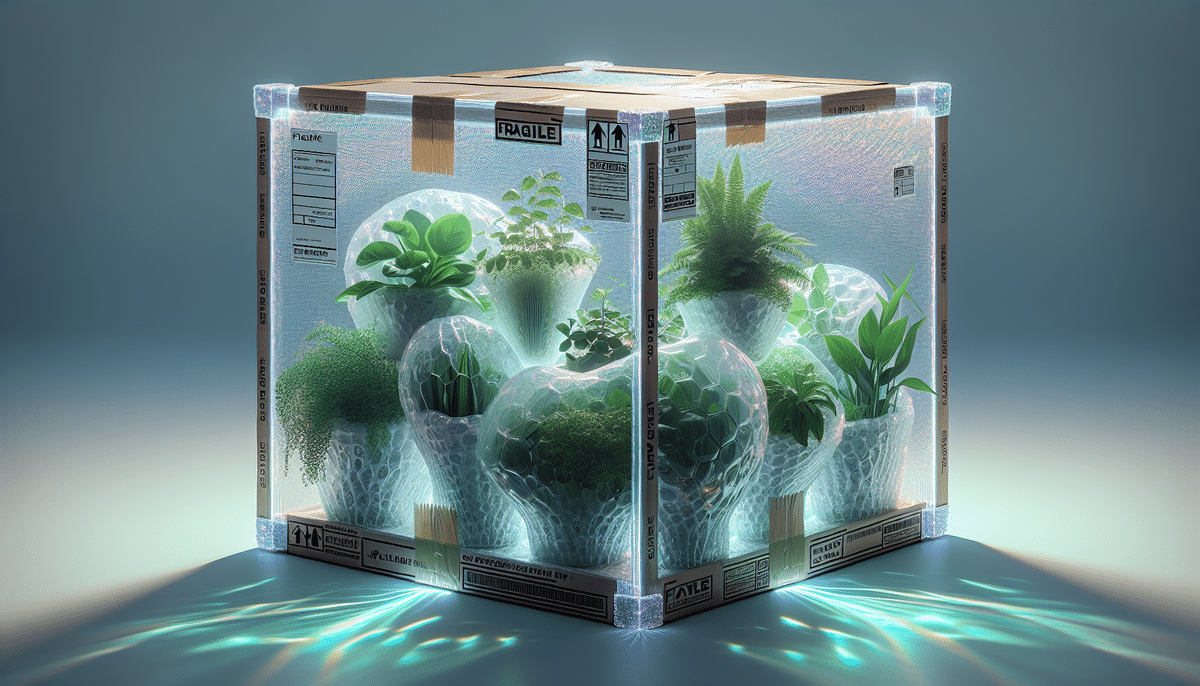UPS Provides Guidelines for Shipping Plants and Plant Materials
If you need to ship plants or plant materials, it's crucial to understand the unique challenges involved. UPS offers comprehensive guidelines to help ensure your plants arrive safely and securely at their destination. From understanding regulations to selecting the right packaging materials, here's everything you need to know about shipping plants:
Why Shipping Plants is Different from Shipping Other Products
Plants are living organisms that require special care and handling during shipment. Unlike other products, they are highly susceptible to damage from changes in temperature, humidity, and moisture. Additionally, certain plants may be subject to regulations governing their transport, including quarantine restrictions or permits.
Furthermore, the packaging for shipping plants must be carefully considered. The packaging should provide adequate protection for the plant while also allowing for proper ventilation. It is important to use materials that are eco-friendly and sustainable, as well as ensuring that the packaging is not too heavy or bulky, which can increase shipping costs. Proper labeling is also crucial, as it helps to ensure that the plant is handled correctly during transit and delivery.
Understanding the Regulations for Shipping Plants Internationally
International shipments of plants are subject to specific regulations, including phytosanitary certificates, export permits, import permits, and quarantine requirements. It's critical to comply with these regulatory requirements to avoid confiscation, fines, or other penalties. Always check with the relevant authorities in advance of shipping to ensure compliance, as regulations may differ depending on the countries involved.
One important consideration when shipping plants internationally is the potential impact on the environment. Some plants are considered invasive species in certain regions, and shipping them could introduce them to new ecosystems where they may cause harm. It's important to research the plants you plan to ship and ensure they are not on any prohibited or restricted lists.
In addition to regulatory requirements, consider the logistics of shipping plants internationally. Plants require special handling to ensure they arrive in good condition, which may include using specialized packaging materials, selecting appropriate shipping methods, and ensuring the plants are not exposed to extreme temperatures or other environmental factors that could damage them during transit.
The Risks Involved in Shipping Plants and How to Mitigate Them
Shipping plants can be risky due to their fragility. The shipping process may expose plants to various hazards, including changes in temperature or humidity, rough handling, and moisture. To reduce these risks:
- Select appropriate packaging materials
- Accurately label your packages
- Choose a carrier experienced in handling live plants
- Consider specialized services like temperature-controlled trucks or storage facilities
UPS recommends insuring your shipment to protect it from any loss or damage that may occur during transport.
Another way to mitigate risks is to prepare your plants properly before shipping. This includes:
- Pruning the plants to reduce their size and weight
- Removing any dead or damaged leaves
- Watering them adequately before packing
- Choosing the right time to ship, avoiding extreme weather conditions
By taking these precautions, you can increase the chances of your plants arriving at their destination in good condition.
Choosing the Right Packaging Materials for Your Plants
Proper packaging materials are vital when shipping plants. Choose materials that offer sufficient protection and support for your plants, including bubble wrap, foam, or packing peanuts. Be sure to:
- Wrap your plants' roots carefully to prevent damage
- Securely pack the pot or container
- Use appropriate boxes or containers that fit your plants properly
- Label the packaging correctly
Additionally, consider the climate and weather conditions during shipping. If shipping during extreme temperatures, insulated packaging materials may be necessary to protect plants from heat or cold. For plants requiring specific humidity levels, include moisture-absorbing materials in the packaging. Research the specific needs of your plants and the shipping conditions to ensure you choose the appropriate packaging materials.
Tips for Properly Labeling Your Plant Shipments
Proper labeling of your plant shipments is crucial to ensure they are handled correctly during transport. Here are some tips:
- Label your boxes or containers according to the carrier's instructions.
- Include labels identifying the contents, any necessary handling instructions, and regulatory permits or certifications.
- Include information about the origin and destination of the package.
- Add a contact name and phone number in case there are any issues or questions regarding the shipment.
Ensure that the labels are securely attached and clearly visible. Use waterproof labels or protective sleeves to keep labels intact throughout the shipping process.
How to Ensure Your Plants Arrive Safely at Their Destination
To ensure your plants arrive safely, work with a courier experienced in handling plants, such as UPS. This minimizes risks of damage during transport. You can also choose services that provide temperature-controlled shipping or storage, especially if the destination has different weather conditions. Additionally, track your package and be available to receive the plants upon arrival.
Proper packaging is also essential. Make sure plants are securely packed in a sturdy box with enough padding to prevent movement during transit. Clearly label the box with the recipient's name, address, and any special handling instructions. Including a note with care instructions for the plants can help the recipient properly care for them upon arrival. These extra precautions help ensure your plants arrive safely and in good condition.
Best Practices for Shipping Live Plants vs. Cuttings or Seeds
Shipping live plants presents more challenges than shipping cuttings or seeds. Cuttings or seeds are less likely to get damaged during shipment and typically do not require special packaging materials. For live plants, protection and support are critical. Ensure:
- Plants are watered adequately before shipment
- Soil is sufficiently moist
- Plants are pruned to reduce size and weight
- Packing materials provide adequate support and protection
How to Handle Unexpected Delays or Problems During Shipment
Despite careful planning, shipping issues may still occur, leading to delays or damage to plants. If you experience a delay:
- Communicate promptly with the recipient and carrier to identify the problem and find solutions.
- Ensure the recipient is aware of tracking information and any changes to the expected delivery time.
Upon delivery, inspect the shipment immediately to ensure it arrived in good condition. If there is any visible damage, contact the carrier as soon as possible to file a claim.
Navigating Customs Procedures and Documentation Requirements When Shipping Plants Abroad
Shipping plants abroad involves navigating customs requirements and documentation, which can be complex. To ensure compliance:
- Consult your carrier or a customs broker for guidance on regulations and documentation.
- Prepare all necessary documents well in advance to avoid delays.
- Research the specific restrictions and requirements of the destination country.
For example, Australia has strict biosecurity requirements. It is mandatory to declare any plant products when arriving or departing from the country. Failing to do so can result in fines or confiscation of the shipment.
Common Mistakes to Avoid When Shipping Plants and Plant Materials
Avoid the following common mistakes when shipping plants to ensure they arrive in the best condition possible:
- Failing to package plants correctly
- Using inappropriate packaging materials
- Ignoring regulations governing the shipment of plants
- Failing to label plants properly
Consult your carrier to understand the correct procedures for preparing plants for shipment, including necessary regulations and documentation for safe and legal transport.
The Importance of Properly Caring for Your Plants Before and After Shipment
Proper care for your plants before and after shipment is essential:
- Before Shipment:
- Ensure plants are healthy and well-nourished.
- Water plants adequately.
- Avoid shipping during extreme temperatures.
- After Shipment:
- Gently remove plants from packaging, providing adequate support to avoid breakage.
- Water plants if necessary.
- Allow plants time to adjust to their new environment.
How UPS is Adapting to Meet the Unique Needs of Plant Shippers
UPS recognizes the unique needs of plant shippers and has developed specialized services to address them. These include:
- Temperature True®: Ensures products in transit are kept within their ideal temperature ranges to maintain plant health.
- Healthcare Services: Tailored solutions for sensitive shipments.
- Expert advisors to assist plant shippers in navigating regulations and documentation.
UPS employs specialized plant carriers, custom packaging solutions, and adheres to international regulations and documentation requirements to ensure the safety of plant shipments.
Resources and Tools Available to Help You Ship Your Plants with Confidence
UPS provides a variety of resources and tools to help you ship your plants with confidence, including:
- Online guides detailing regulations, packaging guidelines, and care instructions.
- Tracking tools to monitor your shipment in real-time.
- Customer service support for any questions or issues.
The UPS website offers extensive information on regulations governing plant shipment, packaging guidelines, and advice on handling plants before and after shipment. Selecting a carrier with experience in handling plants, such as UPS, is essential for ensuring a smooth shipping process.
In conclusion, shipping plants requires special care and attention to ensure their safe arrival at their destination. From selecting the right packaging materials to complying with regulatory requirements, these tips from UPS will help you ship your plants with confidence.






















